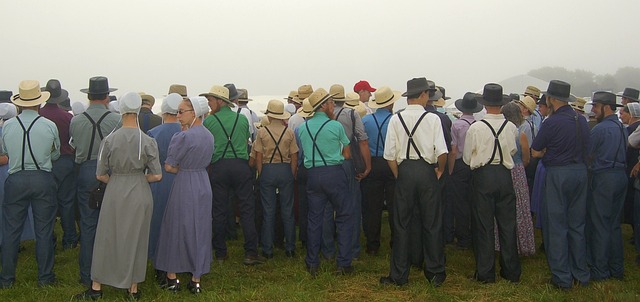The Amish Mennonites are a religious group that emerged from the Anabaptist movement in Europe during the 16th century. They are known for their simple and traditional way of life, which includes a strong emphasis on community, pacifism, and separation from modern society. The Amish Mennonites are a distinct branch within the broader Mennonite community, and they adhere to a set of specific beliefs and practices that guide their daily lives.
Table of Contents
The History and Origins of Amish Mennonites
Are Amish Mennonites?
If you’ve ever wondered about the Amish and their connection to the Mennonites, you’re not alone. Many people are curious about the similarities and differences between these two religious groups. In this article, we’ll explore the history and origins of Amish Mennonites to shed some light on this fascinating topic.
To understand the Amish Mennonites, we need to go back in time to the 16th century. The Mennonites, named after their founder Menno Simons, were part of the Anabaptist movement that emerged during the Protestant Reformation. Anabaptists believed in adult baptism and the separation of church and state, which put them at odds with the established churches of the time.
As the Mennonite movement grew, it faced persecution in Europe. Many Mennonites sought refuge in Switzerland, where they found a more tolerant environment. However, even in Switzerland, they faced challenges and divisions within their own ranks. One group, led by Jakob Ammann, believed in stricter adherence to traditional practices and discipline. This group would later become known as the Amish.
The Amish, then, can be seen as a more conservative branch of the Mennonite movement. They emphasized simplicity, humility, and separation from the world. This meant rejecting modern technology, dressing plainly, and living in close-knit communities. The Amish believed in a literal interpretation of the Bible and sought to live out their faith in every aspect of their lives.
Over time, the Amish migrated to North America, seeking religious freedom and the opportunity to live according to their beliefs. Today, the largest Amish communities can be found in Pennsylvania, Ohio, and Indiana. These communities continue to thrive, with a strong emphasis on agriculture and craftsmanship.
While the Amish and Mennonites share a common history, there are some key differences between the two groups. One of the main distinctions is the level of strictness in their practices. The Amish tend to be more conservative and traditional, while Mennonites can vary in their beliefs and practices. Some Mennonites may embrace modern technology and dress more like the general population.
Another difference lies in the level of community involvement. Amish communities are known for their strong sense of community and mutual support. They often live in close proximity to one another and rely on each other for various aspects of daily life. Mennonites, on the other hand, may have a more dispersed community and may be more integrated into the wider society.
Despite these differences, both the Amish and Mennonites share a commitment to their faith and a desire to live out their beliefs in a tangible way. They both value simplicity, humility, and a strong sense of community. They also both face the challenges of maintaining their traditions in a rapidly changing world.
In conclusion, the Amish Mennonites are a unique religious group with a rich history and a strong sense of identity. While they share a common origin with the Mennonites, the Amish have developed their own distinct practices and beliefs. Whether you’re fascinated by their way of life or simply curious about their connection to the Mennonites, the Amish Mennonites offer a glimpse into a world that is both traditional and timeless.
Key Beliefs and Practices of Amish Mennonites

Are Amish Mennonites?
When it comes to religious groups, there are often misconceptions and confusion surrounding their beliefs and practices. One such group that often raises questions is the Amish Mennonites. Are they the same? Are they different? Let’s delve into the key beliefs and practices of Amish Mennonites to shed some light on this topic.
First and foremost, it’s important to understand that Amish Mennonites are indeed a distinct group within the larger Mennonite community. While they share some similarities, they also have their own unique traditions and customs. So, what are these key beliefs and practices that set them apart?
One of the central tenets of Amish Mennonite faith is a commitment to simplicity and humility. They believe in living a life that is separate from the modern world, often referred to as “the world.” This means rejecting many modern conveniences and technologies, such as electricity and automobiles. Instead, they embrace a simpler way of life, focusing on community, family, and faith.
Another important aspect of Amish Mennonite beliefs is the concept of nonresistance. They adhere to the teachings of Jesus Christ, who preached love, forgiveness, and turning the other cheek. This means that they are pacifists and do not participate in military service or engage in violence. Instead, they strive to resolve conflicts peacefully and promote harmony within their communities.
Community is at the heart of Amish Mennonite life. They believe in the importance of living and working together, supporting one another in times of need. This is evident in their practice of barn raising, where the entire community comes together to construct a barn for a fellow member. It’s a beautiful example of their commitment to communal living and mutual aid.
Education is another area where Amish Mennonites differ from mainstream society. While they value education, they prioritize practical skills and hands-on learning over formal education. Children typically attend Amish schools, which focus on teaching skills that are relevant to their way of life, such as farming and homemaking. This emphasis on practical knowledge helps prepare them for their future roles within the community.
Religious services and worship play a significant role in the lives of Amish Mennonites. They gather regularly for church services, which are typically held in homes or barns rather than dedicated church buildings. These services are characterized by heartfelt singing, fervent prayers, and passionate preaching. The Amish Mennonites believe in the importance of a personal relationship with God and strive to live according to biblical teachings.
In conclusion, while Amish Mennonites are part of the broader Mennonite community, they have their own distinct beliefs and practices. Their commitment to simplicity, nonresistance, community, and practical education sets them apart from mainstream society. By understanding these key aspects of their faith, we can gain a deeper appreciation for the Amish Mennonite way of life.
Similarities and Differences Between Amish and Mennonite Communities
Are Amish Mennonites?
When it comes to the Amish and Mennonite communities, there is often confusion about whether they are the same or different. While they do share some similarities, they are distinct groups with their own beliefs and practices. In this article, we will explore the similarities and differences between the Amish and Mennonite communities, shedding light on their unique identities.
Let’s start with the similarities. Both the Amish and Mennonites are Anabaptist groups, which means they trace their roots back to the 16th-century Protestant Reformation. They both believe in adult baptism, pacifism, and the importance of living a simple and humble life. These shared beliefs have led to a strong sense of community and a commitment to helping others in need.
However, despite these similarities, there are also significant differences between the two groups. One of the main differences lies in their approach to technology. The Amish are known for their rejection of modern technology, while Mennonites tend to be more open to its use. This means that while you may see Amish communities living without electricity or cars, Mennonite communities may have access to these modern conveniences.
Another difference lies in their dress and appearance. The Amish are known for their distinctive clothing, which includes plain dresses and bonnets for women and simple shirts and pants for men. Mennonites, on the other hand, may dress more similarly to the general population, although they still tend to favor modest and conservative attire.
Religious practices also differ between the two groups. Amish worship services are typically held in homes or barns, with a focus on community participation and singing. Mennonites, on the other hand, may have more formal church buildings and services that resemble those of other Protestant denominations.
Education is another area where the Amish and Mennonites differ. Amish education typically ends after the eighth grade, with a focus on practical skills and preparing for a life within the community. Mennonites, on the other hand, often value higher education and may have their own schools or send their children to public or private schools.
Despite these differences, it is important to note that both the Amish and Mennonites are deeply committed to their faith and community. They both value simplicity, humility, and a strong sense of community. Both groups also place a strong emphasis on living out their faith through acts of service and helping others.
In conclusion, while the Amish and Mennonite communities share some similarities, they are distinct groups with their own beliefs and practices. The Amish are known for their rejection of modern technology and distinctive dress, while Mennonites tend to be more open to technology and may dress similarly to the general population. Differences also exist in their religious practices and approach to education. However, both groups are united by their commitment to their faith and community. So, are Amish Mennonites? The answer is no, but they do share some common ground.
Exploring the Modern Lifestyle of Amish Mennonites
Are Amish Mennonites?
When it comes to the Amish and Mennonites, there is often confusion about their similarities and differences. Are they the same? Are they different? Let’s explore the modern lifestyle of Amish Mennonites and shed some light on this topic.
To begin with, it’s important to understand that both the Amish and Mennonites are part of the Anabaptist movement, which originated in the 16th century during the Protestant Reformation. However, while they share some common beliefs and practices, there are distinct differences between the two groups.
The Amish are known for their strict adherence to a traditional way of life. They live in close-knit communities and prioritize simplicity, humility, and separation from the modern world. The use of technology is limited, and they dress in plain clothing, often in shades of black and white. The Amish also practice adult baptism, believing that individuals should make a conscious decision to join the church.
On the other hand, Mennonites have embraced modernity to a greater extent. While they also value simplicity and community, they are more open to using technology and engaging with the outside world. Mennonites can be found in various professions and may dress in a more contemporary manner. They practice both adult and infant baptism, and their churches tend to be more diverse in terms of beliefs and practices.
Despite these differences, there are Amish Mennonites who combine elements of both lifestyles. These individuals may live in Amish communities but adopt some modern conveniences, such as electricity or telephones. They may also dress in a more relaxed manner, while still maintaining a commitment to simplicity and faith.
One of the reasons for this blending of traditions is the influence of the wider society. As the world becomes more interconnected, it becomes increasingly difficult for any community to remain completely isolated. Amish Mennonites, like many other groups, are faced with the challenge of navigating the tension between tradition and modernity.
Another factor that contributes to the diversity within Amish Mennonite communities is the concept of personal conviction. While there are certain core beliefs that unite them, individuals within the community may interpret and apply those beliefs differently. This allows for a range of practices and lifestyles within the broader framework of Amish Mennonitism.
It’s also worth noting that the Amish Mennonite lifestyle is not static. Just as society evolves, so do these communities. Younger generations may be more open to change and may choose to incorporate more modern elements into their way of life. This adaptability ensures the survival and relevance of Amish Mennonite communities in a rapidly changing world.
In conclusion, while the Amish and Mennonites share a common heritage and some similar beliefs, they are distinct groups with different approaches to modernity. The Amish prioritize separation from the modern world and adhere to a more traditional way of life, while Mennonites are more open to engaging with society and embracing modern conveniences. However, within the broader framework of Amish Mennonitism, there is room for diversity and personal conviction. Ultimately, the Amish Mennonite lifestyle continues to evolve and adapt to the challenges of the modern world.
Conclusion
In conclusion, the Amish and Mennonites are distinct religious groups with separate origins and beliefs. While both groups share some similarities, such as their Anabaptist roots and commitment to simple living, they have different practices, traditions, and levels of technological adaptation. Therefore, it is incorrect to consider Amish as Mennonites or vice versa.



